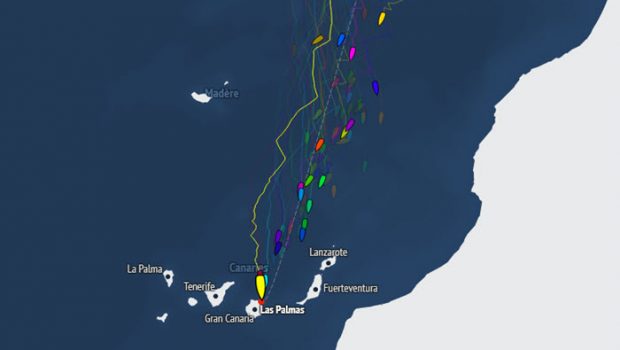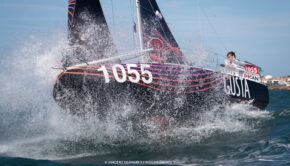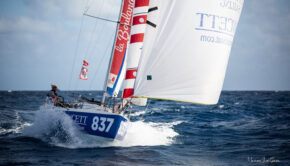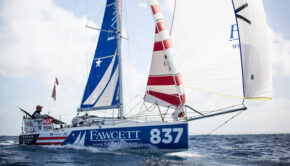Mini Transat: With the finish in sight
Published on October 13th, 2019
(October 13, 2019; Leg 1, Day 9) – The finish of the first leg of the Mini-Transat La Boulangère is imminent in the prototype category. At 15:00 UTC today, François Jambou was just 30 miles from the finish in Las Palmas de Gran Canaria, with Tanguy Bouroullec and Axel Tréhin, respectively, 15 and 25 miles shy of the leader.
Jambou is expected on the finish line from 19:00 UTC, but this estimate is subject to change given the very light wind conditions reigning over the Canaries.
In the production boat category, victory is likely to be played out between Ambrogio Beccaria and Félix de Navacelle. At 15:00 UTC, Ambrogio was leading the way some 80 miles from the finish. The podium for the production boats should be revealed tomorrow.
Overall, the leg has proven slower than the routing had indicated at the start in La Rochelle on October 2. The 1,350 miles leading to Las Palmas have been complex and punctuated by a wide range of weather conditions that have really put the sailors to the test.
Yesterday evening, following on from the retirement of Czech skipper Pavel Roubal (908), Jonathan Chodkiewiez (958), and Jean-Baptiste Ternon (880), a fourth retirement was announced by Yann Blondel (836), who decided that he didn’t have enough time to effect repairs in Leixões near Porto. Indeed, on top of energy issues, he also lost use of his autopilot and had a broken rudder pintle. That leaves 83 skippers out on the racetrack.
Lamenting some technical issues but not planning a pit stop at this stage is Guillaume Coupé (906), who hit a whale three days ago, causing popping of the structural floor of his boat and movement of the keel. Inevitably the boat has suffered some delamination, which he hopes to repair in the Canaries and, in the meantime, he is not pushing the boat too hard.
Spanish sailor Miguel Rondon (954) has no power aboard but is continuing his race. The rudder fitting on the boat skippered by Axelle Pillain (781) has unscrewed itself and cracked so she’s strapped it up in a bid to make it safe. As for Thomas Gaschignard (539) and Bruno Simmonet (757), their energy woes are presently resolved thanks to yesteday’s sunshine.
Back out on the racetrack at last, Briton Joe Lacey (963) has finally got Cape Finisterre behind him and is making nearly 5 knots en route to the Canaries and David Kremer is making around 7 knots in more favourable conditions off the coast of Portugal. Both courageous skippers are sure to be delighted to finally be heading in the right direction after their technical issues…
Ranking at 15:00 UTC
PROTOTYPE
1- François Jambou (865 – Team BFR Marée Haute Jaune) 30.1 miles from the finish
2- Tanguy Bouroullec (969 – Cerfrance) 15.5 miles behind the leader
3- Axel Tréhin (945 – Project Rescue Ocean) 25.5 miles behind the leader
PRODUCTION
1- Ambrogio Beccaria (943 – Geomag) 80.1 miles from the finish
2- Félix De Navacelle (916 – Youkounkoun)10.5 miles behind the leader
3- Julien Letissier (869 – Reno Style) 25.1 miles behind the leader
Event details – Entry list – Tracker – Facebook
Eighty-seven Mini 6.50 solo sailors competing in the biennial Mini-Transat La Boulangère got underway from La Rochelle on the first leg to Las Palmas de Gran Canaria on October 5. The Mini 6.50 Class has competition in two divisions: the prototypes and the production boats.
Production boats are built out of fiberglass, have alloy masts, 1.6 meter draft, and prohibit material such as titanium, carbon fiber, and epoxy resin. Ten boats must have been built to qualify as an official production boat.
Prototypes, on their side, are free of these restrictions and have been, for years, the very first laboratory for sailing innovations. Canting keels, daggerboards, swinging wing masts, long poles for huge spinnakers, have been tried first on minis. New hull shapes with very wide waterlines and foils are the now the latest innovations.
Race Format:
The first leg started October 5 (delayed from September 22 due to storms) from La Rochelle, France and extends 1350 nm to Las Palmas de Gran Canaria. After an often complicated exit of the Bay of Biscay, sailors will expect some long slips down the Portuguese coast before arriving after 7 to 10 days in the Canary archipelago.
The second leg will start November 1 from Las Palmas de Gran Canaria and will take from 15 to 20 sailing days to complete the 2700 nm course and reach Le Marin in Martinique, French West Indies. Due to the numerous islands, the restart from the Canary can be tricky before reaching the famous trade winds that offer a long downwind run.
Source: Effetsmer










 We’ll keep your information safe.
We’ll keep your information safe.